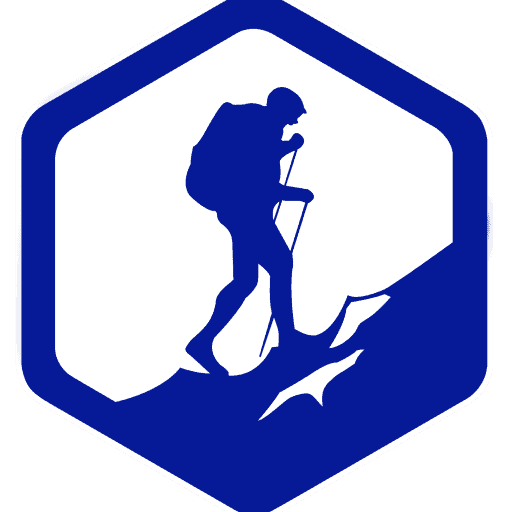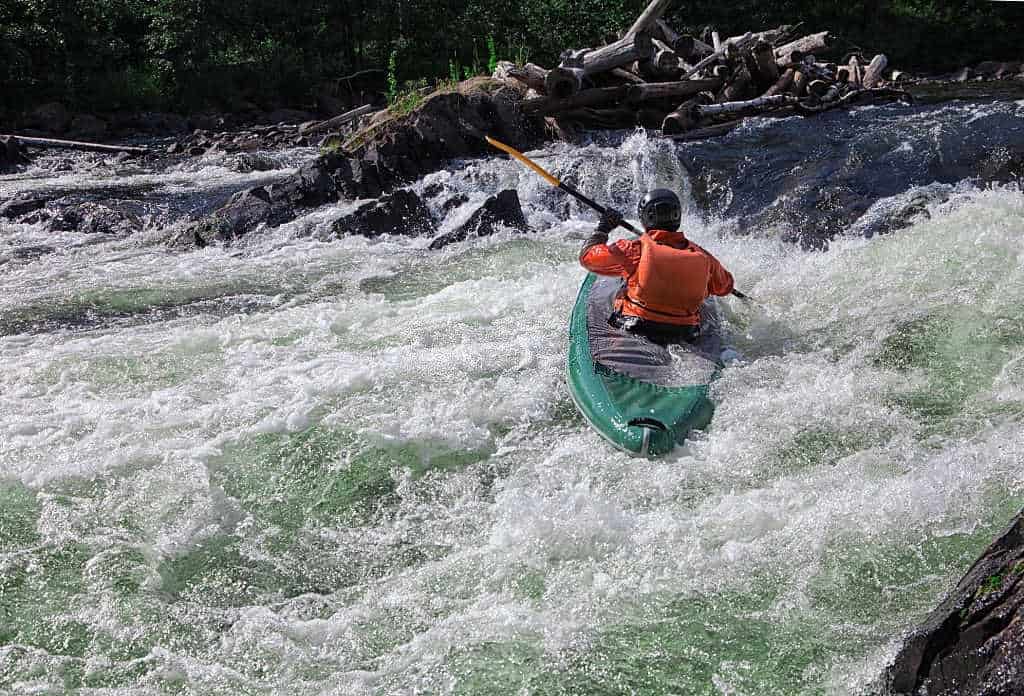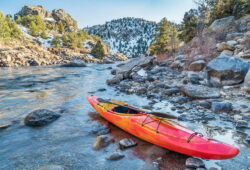If powerful whitewater intimidates you, then you need to learn how to read a river for kayaking.
This is an invaluable skill that will help you to keep safe while at the same time enjoy your time in the water.
Whether you are kayaking alone or with kids, you need to understand how the river works.
So, keep reading to determine these unbelievably simple ways to read a river – and never be taken by surprise ever again!
Contents
Why You Need to Learn How to Read a River for Kayaking
Kayaking is an invigorating and enjoyable activity.
However, there are dangers to consider before you head out in the water.
For instance, whitewater can be quite chaotic and risky to deal with. It is also frightening as this can cause your boat to flip over or lose balance.
When this happens, you are putting your life at great risk.
Unfortunately, not many people are familiar with how currents flow. There are also certain features that impact current strength such as waves, downstream Vs, eddy lines, and so on.
This is why aside from knowing how to read the map when you are out in the wilderness, you need to learn how to read a river for kayaking, as well.
By doing so, it can spare you from danger and make a huge difference between life and death.
Tips on How to Read a River for Kayaking
To read a river, you need to keep in mind a few important things.
These are the basics that will keep you on the safe side while in your boat.
1. Check the downstream V.
It is one of the most essential features of a river. This actually determines any dangers that may be present.
When there is the downstream V, this means that the center is mostly dark water. On the other hand, the V’s edges are the whitewater.
In simpler terms, the Vs point towards a downstream water direction.
If you take a look at the downstream V closely, you will notice the deepest portion of the water. This is, in fact, the best area for you to paddle your kayak through.
So, if you want to map out your kayaking route, you need to determine where the downstream V is. It should lead you to figure out the safest line.
Moreover, this signal shows an area of the river without any obstruction in the water flow. On the other hand, whitewater means there are obstructions such as rocks and debris in the river.
Thus, make it a point to find out where the downstream V is, then you are well on your way to a rapid entryway that’s void of any obstacle.
2. Be on the lookout for eddies.
If you are looking for an exit or a quick rest stop from kayaking, an eddy is what you need. Eddies are mostly stagnant in rivers with slow currents. Therefore, these are excellent places to rest and take a breather.
However, if the waterflow is much faster, it means the eddies are chaotic. The currents are flowing so quickly, which means it is best to stay away from them.
3. Know what hydraulics do and how these impact you.
For the most part, hydraulics are not easy to deal with. If you want to do some exhilarating kayak surfing, then you will find hydraulics very useful.
But if you are just starting out, I would recommend that you avoid hydraulics. You need to improve on your whitewater kayaking abilities more before you do something crazy in the water.
Basically, hydraulics appear in areas where steep drop-offs are present. For instance, you can find these behind big rocks, which generates a massive strength in the back current.
You will notice hydraulics with foamy whitewater with an upstream flow. You want to check for these foamy formations to figure out where the hydraulics are. Be cautious of the fact that hitting hydraulics will cause you to get stuck.
In some cases, people need to swim out just to get away from it. So, be sure to avoid hydraulics and stay safe.
4. Paddle Away from Rocks
It is true that every river has rocks.
These are common in a river, yet that does not mean you can never avoid them.
This is why you first need to know how to create a plan even before you encounter rocks and avoid them as much as you can.
Seeing a rock late enough will make it difficult for you to avoid it. With this in mind, you need to look ahead and make the right move quickly.
I usually check out the direction where I want to go instead of focusing my energy on the rock. If you steer and look in the correct direction, you will have better luck at evading rocks.
But if it is too late, and you are much closer to a rock, you should do what’s counter-intuitive – lean on it. A rock can help you stay stable, as long as you get to it slowly instead of crashing on it.
5. Determine the risks involved with eddy lines.
Lastly, be sure to watch out for eddy lines while kayaking.
These swirling lines are at the eddy’s edges. The only thing you need to know about eddy lines is their instability. They can flip your kayak over when you are in a river with a fast water flow. However, you will be lucky not to suffer any damages if the river is slow-moving.
Read More: Is It Safe To Kayak In Florida? A Practical Guide Before You Head Out
Take a look at this video on how to read a river for kayaking for additional tips that can help you out.
Final Thoughts
Learning how to read a river for kayaking can keep you safe and alive in case the unexpected happens.
I hope that after reading my post, you were able to gain practical tips and advice that will help you improve your kayaking skills. Most importantly, these are all you need to maintain safety while allowing you to enjoy your experience in the waters.




